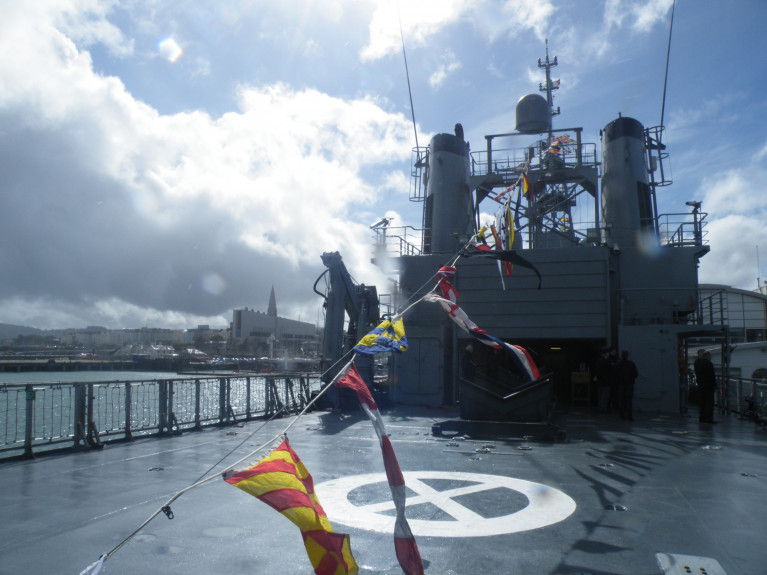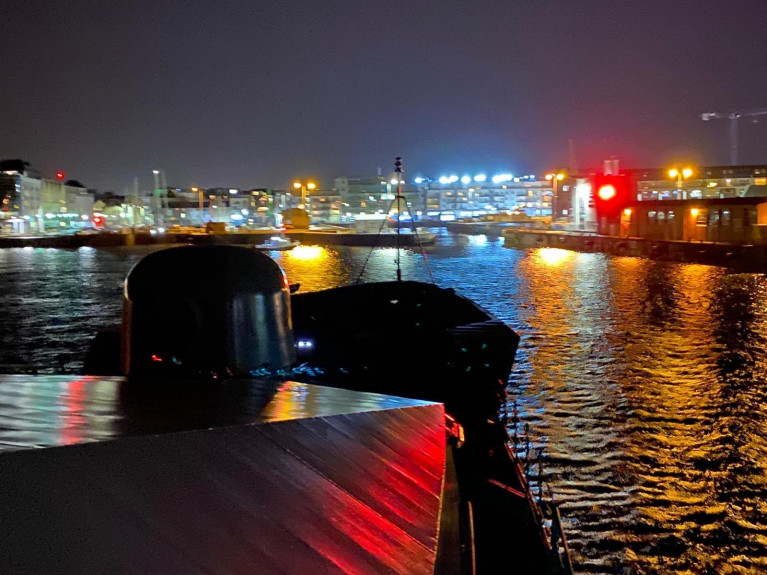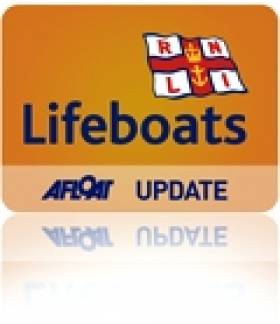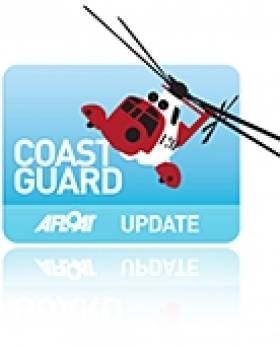Displaying items by tag: HSE
The Naval Service the Irish Examiner understands is preparing to bring back into service its flagship, LÉ Eithne, to carry out Covid-19 virus testing in Cork city.
The vessel has the largest upper deck space (as above) of any of the navy's ships and would be ideal for such an operation.
She was taken off seagoing operations last June, along with coastal patrol vessel, LÉ Orla, due to manpower shortages.
While she was taken off operational duties, she was still maintained and the finishing touches are now being made to equip her to aid the HSE in virus testing.
It is expected that she will shortly tie up at Horgan's Quay, the longest quay in the city. The quayside is expected to be freed-up to provide parking spaces for those seeking testing.
Navy personnel will be trained to carry out the tests by HSE staff.
The reason the navy is being brought in to do the testing is because it acquired a vast amount of experience in medical screening while helping to save 18,000-plus migrants during Operations Sophia and Pontus in the Mediterranean Sea.
It is also used to wearing PPEs (Personal Protective Equipment).
The ships are also self-sufficient. They have onboard sanitary facilities, kitchens, accommodation and water-making facilities.
The Flag Officer commanding the Naval Service, Commodore Michael Malone, addressed his personnel on social media telling them that the public will be looking at them for "assurance and strong leadership".
He said that all non-essential activities in the Defence Forces had been suspended. For more click HERE..
The deployment of the flagship Afloat adds is the third Navy vessel put into such a vital role, LÉ Samuel Beckett went to Dublin followed by LE William Bulter Yeats to Galway yesterday.
To keep pace of further news click the Naval Service twitter link and overall for the Defence Forces here.
Use of Naval Ships Looked by HSE to Scale up Covid-19 Testing Across Country (Includes Port of Galway)
In efforts by the HSE which is continuing to expand on its Covid-19 testing capabilities, tens of thousands of people calling to seek a test for the virus.
At a HSE briefing (yesterday, 17 March), officials urged people not to call the emergency line 112/999, warning that over the weekend people were “clogging up” the service.
“This is a real concern for us,” HSE CEO Paul Reid said.
For much more the Journal.ie reports that also referred in its story that officials pointed out that members of the Irish Navy have “considerable experience” with this kind of work in the Mediterranean and would be well equipped to handle it.
Afloat adds the Naval Service LÉ William Butler Yeats (as above) last night arrived at the Port of Galway where it docked as part of Óglaighnahéireann’s efforts to generate more capacity for the HSE.
The deployment follows that of sister of the OPV90/P60 class LÉ Samuel Beckett berthed in Dublin Port to also assist in fighting Covid-19. This is the second such ship (so far) that Afloat is aware involved in such critical operations.
Skerries RNLI Crew Shadows Ambulance Teams in Unique Learning Experience
#RNLI - Skerries RNLI volunteer crew recently undertook an exercise the likes of which they had not done before - shadowing a local ambulance team to observe how they respond to emergencies.
Philip Ferguson, a Skerries RNLI crew member, is also an advanced first responder with the local Dublin fire brigade. He has been on many sea rescues and call outs, and though not all have resulted in an ambulance being called to the scene, there are always those incidents that do require their specialist services.
In this regard, Ferguson believed that for the local lifeboat crew to witness how the ambulance teams operate would provide invaluable experience to the crews.
He approached Skerries RNLI lifeboat operations manager Niall McGrotty and divisional operations manager Owen Medland with his idea to discuss the possibility of some of the local RNLI crew joining the ambulance teams on some of their shifts in an observational capacity. They would not be allowed to take part or assist the HSE crew at any point, they were there to look and learn.
Both agreed that it was an exercise worth pursuing, and an arrangement was then made with the local HSE ambulance base in Swords. Over a period of three weeks, all of the RNLI crew took either a day or a night shift with the HSE ambulance crews. As the ambulance teams were called out, the RNLI volunteer rode along in the ambulance, observing the HSE teams at work be it at roadside after car crashes or to the homes to which they were called.
They witnessed first-hand the long hours and the dedication put in by the HSE ambulance teams as they waited in A&E at hospitals and transported their patients with care. Each individual who went on the exercise said it was, without doubt, an enlightening experience.
They also witnessed the professionalism of the HSE ambulance crews in sometimes very difficult circumstances. They saw how the ambulance crews worked with each other, their partners, and how they did their utmost to provide care and attention to the patient as they reviewed the situation, analysed the needs of the patient and did what was necessary to stabilise and transport that individual to hospitals. Each of the RNLI crew who went on the training came back with renewed and utmost respect for the ambulance crews.
The RNLI volunteer crew has not yet had to put their latest training to the test in 2013. However, with the knowledge they gained on the observational placements, they have added to their skills.
Such was the success of this exercise between that it is hoped it can be repeated. Skerries RNLI would like to thank each of the HSE ambulance crews for allowing them to spend time with them and learn.
The Irish Coast Guard today successfully assisted the HSE in a medical evacuation of a young transplant patient from Dublin to London. The request for assistance was received by the Coast Guard at 2am this morning and involved a very critical timeframe. In ten minutes, the Dublin-based Coast Guard helicopter crew were assembled and briefed and shortly afterwards, the helicopter and crew were en-route to Heathrow airport in London with the young patient, who was later transferred to Kings Cross Hospital.
The medical evacuation this morning was just one of a number of similar incidents involving Coast Guard crews around Ireland in the past 24 hours. At 11am yesterday Dublin Coast Guard coordinated the rescue by the RNLI or 6 children and an adult from overturned canoes off Clogherhead. At 16:38pm yesterday the Shannon-based Coast Guard helicopter lifted an injured crewmember from a fishing vessel in the Shannon Estuary where he were later transferred by ambulance to the mid-Western Regional Hospital. At 17:52pm yesterday evening the Castletown Coast Guard Unit were tasked to respond to a call of an injured person on rocks at Ballydongen Beach, Allihies, Co. Cork. At 7:56am this morning, the Sligo-based Coast Guard helicopter evacuated an ill crewmember from a fishing vessel 105 miles west of Loop Head with the Shannon Coast Guard helicopter standing by as top cover for the long distance operation.
Speaking today, Director of the Irish Coast Guard Chris Reynolds said: “It might seem like a busy 24 hours for the Coast Guard – but this is nothing out of the ordinary for our teams, who operate on a 24/7 basis and are always on standby in the event of emergencies. I would like to congratulate all of our teams who were involved in the successful medical evacuations that took place in the 24 hours. In particular, the evacuation at very short notice of the young transplant patient this morning. It is very unusual for the Coast Guard to operate out as far east as London, but we are delighted that the transfer went smoothly and that we could help.“

































































